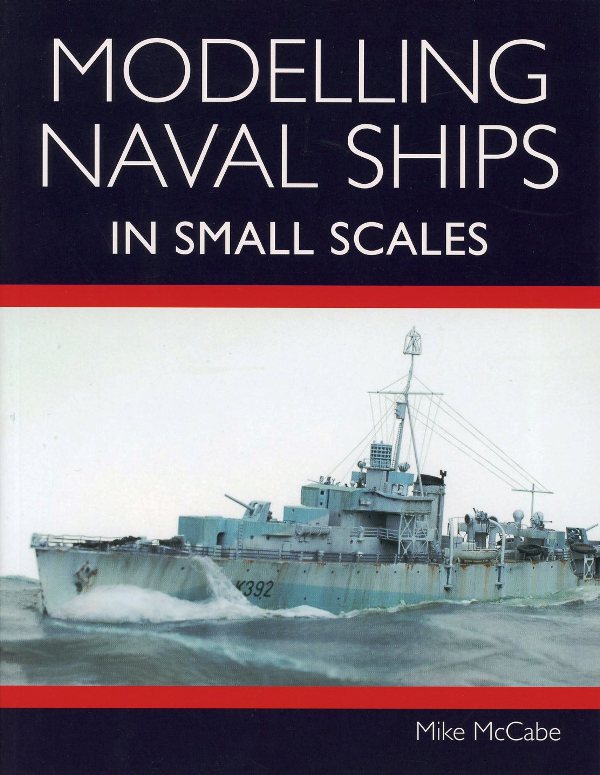by Mike McCabe


| Reviewed by Martin J Quinn October 2021 |
|||||||||
|
Mike McCabe of Starling Models has published book aimed at ship modelers: Modeling Naval Ships in Small Scales. Part of the purpose of the book, as stated in the introduction, is to "...act as part guide, part inspiration to you as a modeler to use some of the techniques yourself." |
|||||||||
This book has 141 pages (not including the
Index), with an Introduction and 11 chapters. The chapters are:
The first chapter covers everything from the difference in scales, the methods of production, accessories available, and the difference between waterline and full hull. Chapter 2 focuses on the things you'll need to build your ship model: cutters, sanding tools, adhesives, etc. The third chapter takes you step by step in building an injection molded kit right out of the box. Along the way in the book, there are what I'd call "spotlight" pages, that focus on a particular area. In Chapter 3, this highlights working with photo-etch parts. The fourth chapter helps you improve your basis injection molded kit, by thinning splinter shields, replacing kit parts, working with photo-etch and using aftermarket decks. Chapter 5 gets you familiar with resin kits - what the differences are between a resin kit and an injection molded kit, how to remove and clean up the parts, and tips on how to safely work with resin. This chapter leads into the next, Chapter 6, where Mr. McCabe guides you through building a resin model, using his own HMS Nadder as the test subject. Now that you built your kit - what about the finish? Chapter 7 takes you though painting and weathering. It explains about airbrushing and it's associated equipment, what types of paints are commonly available, and guides you through how to paint your model. The chapter wraps up with a tutorial on weathering your model, with discusson on pre-shading, sealing the paint and adding highlights, and more. Next up is a chapter on masts and rigging, detailing what types of materials you'll need, from the masts and spars, to the rigging material itself. Mike goes into some detail on soldering masts, as section that I am going to pay particular attention to. The chapter ends with a section on making and hanging flags. You've got your model built, painted, with nice masts and fancy rigging. What now? Chapter 9 shows you how to "show a finished model in its natural element, the water". Putting your model in a seascape, as the author indicates, allows for a lot of individuality and creativity, and the results can be quite dramatic, if done right. The chapter covers everything from water color, waves and wave patterns, what materials to use, and how to create a proper wake, along with other tips. The 10th chapter walks you through how to up your game and improve and super detail the out of the box product. In this case the author uses the Academy 1/350 Admiral Graf Spee as his base kit, along with photo-etch sets from Eduard and White Ensign as well as aftermarket upgrades from Veteran Models. By using these upgrade sets, along with some scratchbuilding, the model goes from just an out of the box build to much more interesting and detailed replica. The last chapter focuses on the choosing the best case for your finished piece, and tips on how to photograph it, so you can share it with all your modeling friends from around the world, right here in the Modelwarships gallery! There is more focus on photography than display bases here, and that's probably a good thing, as I think a lot of modelers struggle with taking good pictures of their finished projects. Here Mr. McCabe talks about Depth of Field, the background and lighting. He also mentions how scale modeling, once a very solitary hobby, as become much more social, with the spread of that worldwide web thing. |
click to
enlarge images |
||||||||
|
|||||||||
| Conclusions:
No matter how long you've been building models, whether you are a newbie or an experienced modeler, there is always something to learn. While I haven't had the time to read this cover to cover, just casually reading through it has already given me a few ideas and inspirations. I think many ship modelers might find it worth having a copy near their workbench. Recommended, especially for those just getting into - or getting back into - the hobby, or those modelers looking to improve their skill set. This is Modeling Naval Ships in Small Scales, by Mike McCabe. Published by The Crowood Press, ISBN 978-1-78500-800-4. The books retails for $24.99 US is available online. My copy came courtesy of my wallet, and was purchased via Amazon Smile, which donates a portion of purchases to the charity of your choice. Mine is the Michael Mosier Defeat DIPG charity. If you shop via Amazon, please consider using the Amazon Smile option. |
|
||||||||
